Mongan, Deirdre  ORCID: https://orcid.org/0000-0003-3616-4253 and Millar, Seán
ORCID: https://orcid.org/0000-0003-3616-4253 and Millar, Seán  ORCID: https://orcid.org/0000-0003-4453-8446
(2025)
Results from the 2023 Healthy Ireland Survey on drug use in Ireland.
Drugnet Ireland,
Issue 92, Autumn 2025, Supplement,
pp. 8-13.
ORCID: https://orcid.org/0000-0003-4453-8446
(2025)
Results from the 2023 Healthy Ireland Survey on drug use in Ireland.
Drugnet Ireland,
Issue 92, Autumn 2025, Supplement,
pp. 8-13.
| Preview | Title | Contact |
|---|---|---|
|
PDF (Drugnet Ireland 92, supplement)
970kB |
Ireland has conducted five general population surveys on drug use (2002–03, 2006–07, 2010–11, 2014–15, and 2019–20). The first four surveys were conducted simultaneously in Ireland and Northern Ireland.1 The 2019–20 survey was conducted in Ireland only and was managed by the Health Research Board (HRB), which commissioned Ipsos B&A to conduct this survey on its behalf.2
In 2022, the Department of Health Drugs Policy Unit and the HRB requested that questions on drug use prevalence be included in the 2023 Healthy Ireland Survey rather than undertaking a standalone study. Potential respondents were sampled using a two-stage telephone random digit dialling approach. Mobile phone numbers were used, as there is almost universal ownership of mobile phones in Ireland. Before proceeding with a telephone interview, informed consent was obtained from the individual and parental consent was obtained for those aged under 18 years. The survey response rate was 50%. The module on drug use was only included for respondents who opted into the module. A total of 6,407 out of the total 7,411 survey respondents agreed to participate in the drug use module, thus providing a participation rate of 86.5% of survey respondents, or 43.5% of the total sample. The sample was weighted by sex, education, work status of the respondent, and region, using population statistics from the Central Statistics Office, to ensure that it was representative of the general population. The main measures were lifetime use (ever used), last-year use (recent use), and last-month use (current use).3
Use of any illegal drug
The proportion of respondents aged 15–64 years who reported using any illicit drug in their lifetime has decreased slightly from 27.1% in 2019–20 to 26.2% in 2023 (see Figure 1). Similarly, last-year and last-month prevalence of any illegal drug use has remained stable since 2019–20; from 9.0% to 8.8% and 4.9% to 4.0%, respectively. ‘Any illicit drug’ refers to cannabis, ecstasy, cocaine, ketamine, magic mushrooms, amphetamines, lysergic acid diethylamide (LSD), and new psychoactive substances (NPS).
Illicit drug use was more prevalent in males and also greater among young adults, with 17.0% of persons aged 15–34 years having reported illegal drug use within the previous year (compared with 17.7% in 2019–20). Results from the 2023 survey indicated that the most commonly used illicit substances in Ireland, based on last-year prevalence, were cannabis (7.4%), cocaine (2.4%), ecstasy (1.0%) and magic mushrooms (1.0%).
Overall, those aged 15–24 years were most likely to report any drug use and this was particularly the case for cannabis and ketamine (Figure 2). Magic mushrooms use was most common among 25–24-year-olds, while similar proportions of 15–24-year-olds and 25–34-year-olds reported cocaine use.
Ireland has conducted five general population surveys on drug use (2002–03, 2006–07, 2010–11, 2014–15, and 2019–20). The first four surveys were conducted simultaneously in Ireland and Northern Ireland.1 The 2019–20 survey was conducted in Ireland only and was managed by the Health Research Board (HRB), which commissioned Ipsos B&A to conduct this survey on its behalf.2
In 2022, the Department of Health Drugs Policy Unit and the HRB requested that questions on drug use prevalence be included in the 2023 Healthy Ireland Survey rather than undertaking a standalone study. Potential respondents were sampled using a two-stage telephone random digit dialling approach. Mobile phone numbers were used, as there is almost universal ownership of mobile phones in Ireland. Before proceeding with a telephone interview, informed consent was obtained from the individual and parental consent was obtained for those aged under 18 years. The survey response rate was 50%. The module on drug use was only included for respondents who opted into the module. A total of 6,407 out of the total 7,411 survey respondents agreed to participate in the drug use module, thus providing a participation rate of 86.5% of survey respondents, or 43.5% of the total sample. The sample was weighted by sex, education, work status of the respondent, and region, using population statistics from the Central Statistics Office, to ensure that it was representative of the general population. The main measures were lifetime use (ever used), last-year use (recent use), and last-month use (current use).3
Use of any illegal drug
The proportion of respondents aged 15–64 years who reported using any illicit drug in their lifetime has decreased slightly from 27.1% in 2019–20 to 26.2% in 2023 (see Figure 1). Similarly, last-year and last-month prevalence of any illegal drug use has remained stable since 2019–20; from 9.0% to 8.8% and 4.9% to 4.0%, respectively. ‘Any illicit drug’ refers to cannabis, ecstasy, cocaine, ketamine, magic mushrooms, amphetamines, lysergic acid diethylamide (LSD), and new psychoactive substances (NPS).
Illicit drug use was more prevalent in males and also greater among young adults, with 17.0% of persons aged 15–34 years having reported illegal drug use within the previous year (compared with 17.7% in 2019–20). Results from the 2023 survey indicated that the most commonly used illicit substances in Ireland, based on last-year prevalence, were cannabis (7.4%), cocaine (2.4%), ecstasy (1.0%) and magic mushrooms (1.0%).
Overall, those aged 15–24 years were most likely to report any drug use and this was particularly the case for cannabis and ketamine (Figure 2). Magic mushrooms use was most common among 25–24-year-olds, while similar proportions of 15–24-year-olds and 25–34-year-olds reported cocaine use.
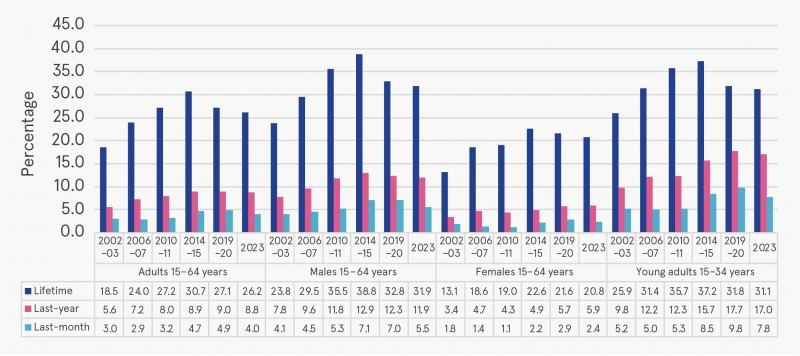
Figure 1: Lifetime, last-year and last-month prevalence of any illicit drug use in Ireland, 2002–03, 2006–07, 2010–11, 2014–15, 2019–20, and 2023
Source: Mongan et al. (2025)
Note: Any illicit drug refers to cannabis, ecstasy, cocaine, ketamine, magic mushrooms, amphetamines, lysergic acid diethylamide (LSD), and new psychoactive substances (NPS).
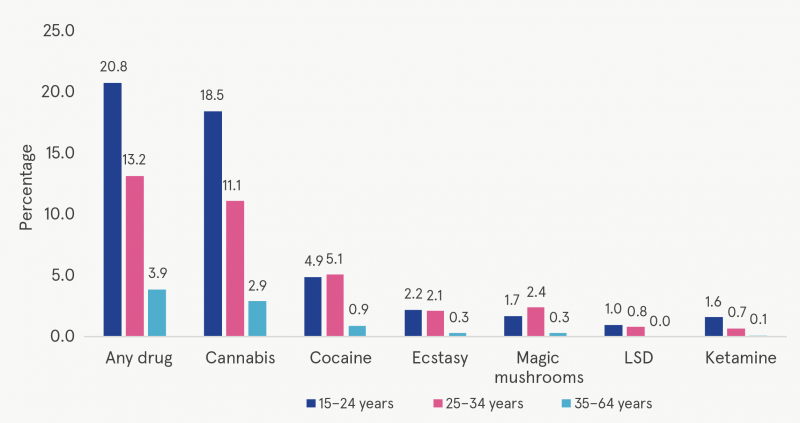
Figure 2: Recent use of illicit drugs, by drug type and age group
Source: Mongan et al. (2025)
Cannabis use
Findings from the survey revealed that 24.1% of the population (aged 15–64 years) had used cannabis at some point in their lives; 7.4% reported use in the year prior to the survey and 3.4% in the preceding month (see Figure 3).
Similar to earlier surveys, rates of cannabis use were greater among men than women: for lifetime use (29.7% versus 18.6%); last-year use (10.1% versus 4.8%); and last-month use (4.9% versus 2.0%). Since 2002–03, lifetime, last-year and last-month rates of cannabis use among males have increased by 33.8%, 40.3% and 44.1%, respectively. Lifetime and last-year use of cannabis among females has also increased. However, last-month prevalence in women has remained relatively stable over time.
The prevalence of cannabis use was noticeably higher among young adults, with lifetime, last-year and last-month rates being higher than those recorded in 2019–20, at 28.7%, 14.8% and 6.8%, respectively.
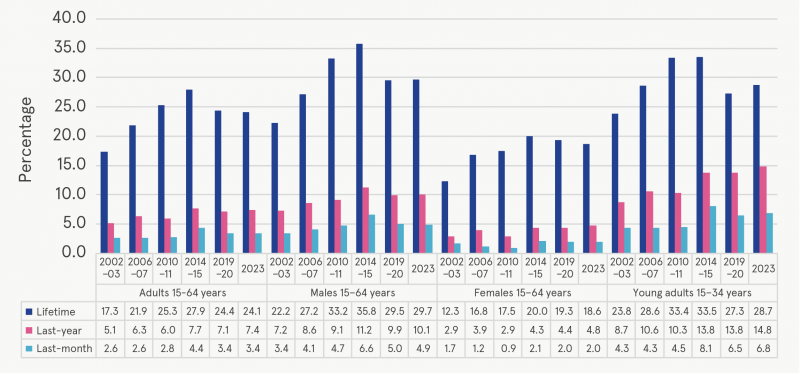
Figure 3: Lifetime, last-year and last-month prevalence of cannabis use in Ireland, 2002–03, 2006–07, 2010–11, 2014–15, 2019–20, and 2023
Source: Mongan et al. (2025)
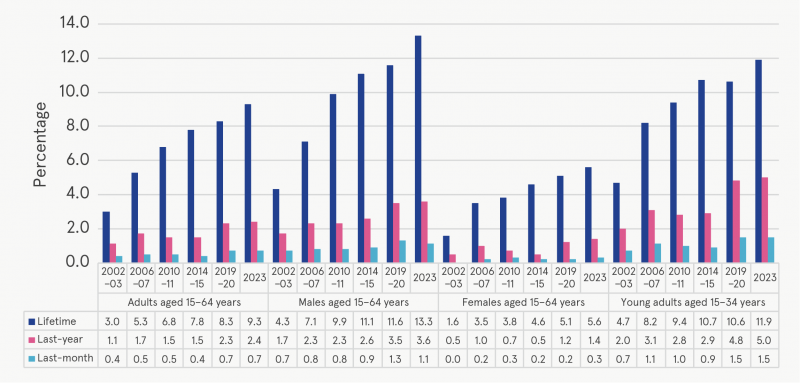
Figure 4: Lifetime, last-year and last-month prevalence of cocaine use in Ireland, 2002–03, 2006–07, 2010–11, 2014–15, 2019–20, and 2023
Source: Mongan et al. (2025)
Cocaine use
Lifetime cocaine use has increased when compared with 2019–20 rates (see Figure 4). The percentage of respondents aged 15–64 years who reported using cocaine (including crack) at some point in their lives increased from 8.3% to 9.3%. As was observed in previous surveys, more men than women reported using cocaine in their lifetime (13.3% versus 5.6%).
Since the 2019–20 survey, recent cocaine use among males and females has remained relatively stable, at 3.6% and 1.4%, respectively. Lifetime and last-year use of cocaine among young adults has increased slightly, from 10.6% to 11.9% and 4.8% to 5.0%, while current use among 15–34-years olds was unchanged at 1.5%.
Ecstasy use
Results from the 2023 survey demonstrate notable reductions in the use of ecstasy (see Figure 5). In
2019–20, ecstasy was found to be the second most commonly used illegal drug in Ireland (after cannabis) in the year prior to the survey, at 2.7%. However, only 1.0% of survey respondents aged 15–64 years indicated last-year ecstasy use in 2023. Recent use of ecstasy among males and females declined from 3.9% to 1.4% and 1.6% to 0.6%, respectively.
Notable decreases in ecstasy use were also observed among those aged 15–34 years. In 2023, 9.4% of young adults said they had tried ecstasy at least once in their lifetime (compared with 13.7% in 2019–20), 2.2% had tried it in the last year (compared with 6.5% in 2019–20) and less than 1.0% indicated current ecstasy use (compared with 3.1% in 2019–20).
Sedative/tranquilliser use
Recent sedative/tranquilliser use was reported by 7.0% of the adult population, with females more
likely than males to report use (10.2% versus 3.7%). Those aged 65 years and older were more likely than younger age groups to report recent sedative/tranquilliser use (9.8%). Females aged 65 years and older had the highest prevalence of recent use (14.8%), while males aged 25–34 years had the lowest prevalence, at 1.4% (see Figure 6).
Of those who had used sedatives/tranquillisers in the last year, 90.6% stated that all were prescribed, 5.8% stated that none were prescribed, and 3.6% stated that some were prescribed while others were not. Males were more likely than females to use sedatives/tranquilisers that were not prescribed (17.9% versus 6.6%). Younger respondents were also more likely to use non-prescribed sedatives/tranquillisers; 17.4% of 25–34-year-olds compared with 5.0% of those aged 65 years and over reported this.
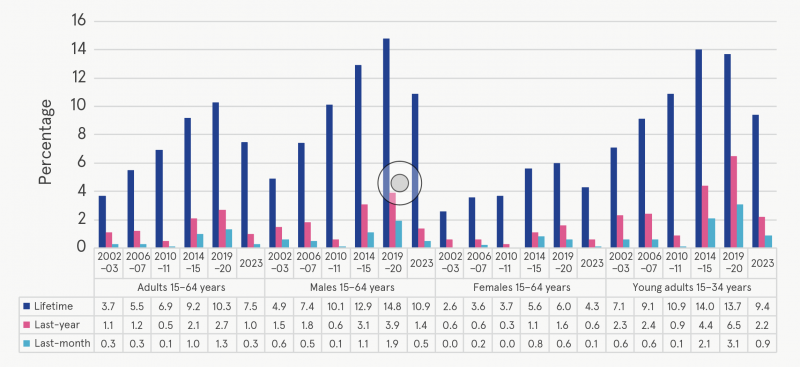
Figure 5: Lifetime, last-year and last-month prevalence of ecstasy use in Ireland, 2002–03, 2006–07, 2010–11, 2014–15, 2019–20, and 2023
Source: Mongan et al. (2025)
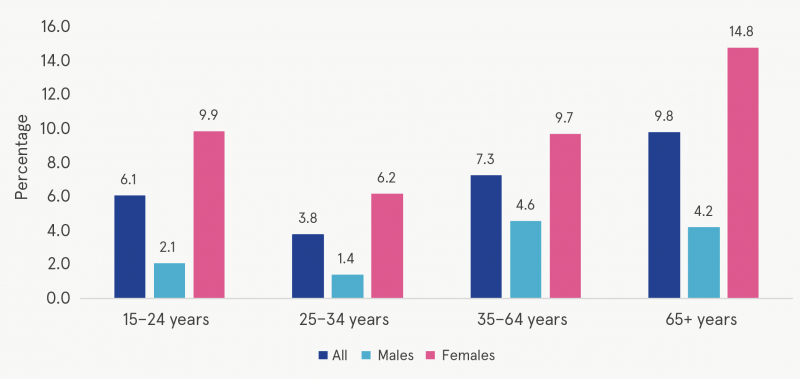
Figure 6: Last-year use of sedatives/tranquillisers, by sex and age group
Source: Mongan et al. (2025)
Conclusion
Although results from the 2023 Healthy Ireland Survey suggest that the prevalence of illicit drug use has stabilised in Ireland, there have been changes regarding the types of drugs used, with notable reductions in the use of ecstasy, while the prevalence of cocaine use remains high. Although NPS use was included as a drug category in the 2023 Healthy Ireland Survey, results demonstrate that the prevalence of recent NPS use remains very low in Ireland, at 0.3% (compared with 0.8% in 2019–20). This likely highlights the continued impact of the Criminal Justice (Psychoactive Substances) Act 2010, which made the sale, import, export, or advertisement of unregulated psychoactive substances for human consumption illegal. The Act also gave appropriate powers to An Garda Síochána and the courts to intervene quickly in order to prevent trade in a non-criminal procedure via the use of prohibition and closure orders.
It should also be noted that it is not possible to assess what impact the change in survey mode and sampling procedure has had on respondents’ answers. Therefore, caution is recommended when comparing findings from the 2023 Healthy Ireland Survey with previous drug prevalence surveys conducted in Ireland. In addition, unlike previous surveys, it is not possible in this Healthy Ireland Survey to report results by level of deprivation, Regional Drug and Alcohol Task Force area or Community Health Organisation area.
1 National Advisory Committee on Drugs and Alcohol and Department of Health (UK) (2016) Prevalence of drug use and gambling in Ireland and drug use in Northern Ireland. Bulletin 1. Dublin: National Advisory Committee on Drugs and Alcohol. Available from: https://www.drugsandalcohol.ie/26364/
2 Mongan D, Millar SR and Galvin B (2021) The 2019–20 Irish National Drug and Alcohol Survey: main findings. Dublin: Health Research Board. Available from: https://www.drugsandalcohol.ie/34287/
3 Mongan D, Millar SR and Galvin B (2025) Drug use in Ireland 2023: findings from the Healthy Ireland survey. Dublin: Health Research Board. Available from: https://www.drugsandalcohol.ie/43420/
B Substances > Cannabis / Marijuana
B Substances > Hallucinogens / Psychedelics > LSD (Lysergic acid diethylamide)
B Substances > Hallucinogens / Psychedelics > Mushrooms (psilocybin)
B Substances > Sedatives, hypnotics or tranquillisers (CNS depressants)
B Substances > CNS stimulants > MDMA / Ecstasy
B Substances > Cocaine
B Substances > New (novel) psychoactive substances
B Substances > New (novel) psychoactive substances > Aminoindanes / Arylalkylamines / Arylcyclohexylamines > Ketamine
T Demographic characteristics > Adolescent / youth (teenager / young person)
T Demographic characteristics > Adult
T Demographic characteristics > Young adult
VA Geographic area > Europe > Ireland
Repository Staff Only: item control page